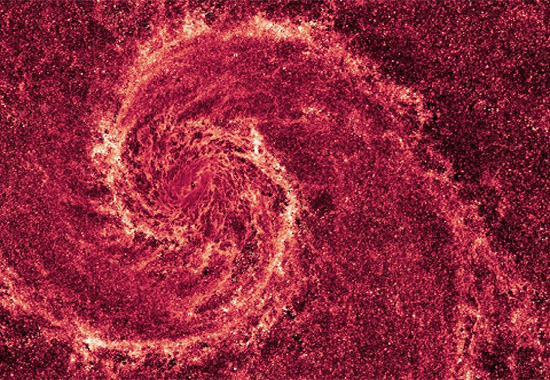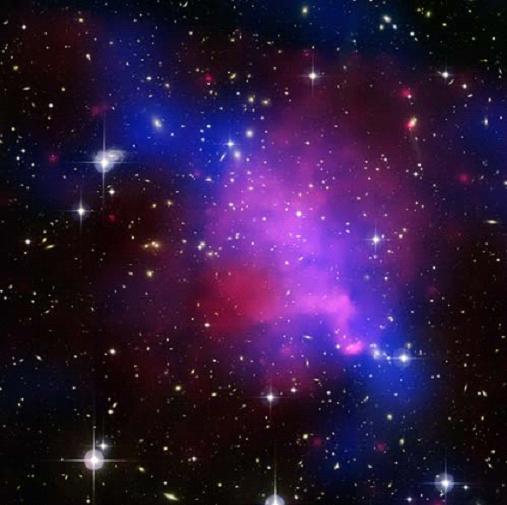
Detailed infrared image of electrically charged dust in M51, The Whirlpool Galaxy. Credit: NASA, ESA, M. Regan and B. Whitmore (STScI), R. Chandar (University of Toledo), S. Beckwith (STScI), and the Hubble Heritage Team (STScI/AURA)
Jan 27, 2012
It is common knowledge that electric charge must flow in a circuit in order for a magnetic field to be created.
On May 30, 1908, Nobel laureate Hannes Olof Gösta Alfvén was born in Norrköping, Sweden. His work in plasma physics, and the motion of charged particles in particular, is foundational to Electric Universe theory.
In the 1930s, Alfvén proposed that the Milky Way contained a large-scale magnetic field, so cosmic rays (charged particles) could move in spiral orbits along its arms. His contention was that, if plasma were a fundamental component of the galaxy, the plasma would facilitate a flow of electric charge, and thus the magnetic field would arise. Since it was “known” at the time that space was a vacuum, cosmic electromagnetic forces and particle beams were considered nonexistent by conventional astrophysicists.
Today, astronomers continue to ponder how magnetic fields are generated around stars and galaxies. They still do not know what gives those fields their shape and their strength. Most astronomers believe that galaxies are gravitationally bound clouds of hydrogen gas and dust that coalesced over millions (if not billions) of years, so electricity as a formative and continuously active agent escapes their notice.
Magnetic fields in space are thought by modern astronomers to be “primordial” fragments left over from the Big Bang. They rely on that idea as an explanation for how the galaxies in the Universe were formed.
A press release from April 2010 reported that one model of galaxy formation indicated that cool gas falling into a galaxy, supernovae explosions, star birth, and the rotation of the galaxy itself are responsible for creating galactic magnetic fields. However, several other factors in their model were missing, since they were not able to predict the fields observed in several galactic structures.
According to a more recent press release, researchers using laser pulses “created certain conditions analogous to those in the early universe when galaxies were forming.” How they know what those conditions were is an important question. Nonetheless, their “new” understanding is that the Biermann battery process generates magnetic fields.
In the 1950s, Biermann realized that a magnetic field can be generated by the motion of charged particles. Since clouds of charged particles stream through space, any separation of charge in those clouds will initiate an electric field. As has been stated many times in these pages, an electric field, no matter how weak, will cause an electric current: ipso facto, a magnetic field will appear.
Although the “revelation” that electric currents lead to magnetic fields in galaxies is refreshing, it is noticeable that astronomers continue to rely on “shockwaves” and “bubbles” to explain the starting point. Charge separation as a primary condition of the Universe is not considered.
Another fact that is not considered is that charged particles must move in a circuit. While the consensus scientific worldview only permits isolated “island galaxies” in space, the Electric Universe emphasizes connectivity with an electrically active network.
Galaxies are enmeshed in a circuit of electricity that flows through the cosmos from beginning to end. There is no way to know where the current comes from or where it is going, but we see it in the electromagnetic fields and synchrotron radiation that permeate space.
Stephen Smith
Hat tip to Larry White

Cosmic bubble structure in Abell 520. Credit: NASA/CXC/M. Weiss
Oct 06, 2008
Bubble Magnets
Astronomers say that exploding bubbles of magnetic energy might have helped form galaxy clusters.A little over fifty years ago, before space shuttles, before the Hubble Space Telescope, and before satellite technology, electricity in space was not considered. Because the first teams of space scientists were "steely eyed missile men" with backgrounds in aeronautics and chemical fuel reactions, when evidence for electric current flow around Earth was found it was called a "radiation belt."
Although Kristian Birkeland had conducted experiments almost fifty years before the first science package was launched into Earth orbit, electricity remained unfamiliar to researchers conditioned to think in terms of gravity and mass. They had no concept of charged particles generating filamentary structures that could interact and create energetic phenomena—Birkeland's terella research and his study of Earth's aurorae were forgotten.
That lack of familiarity continues today when moving charged particles from the Sun are called a “wind” instead of an electric current. Charged particles impinging on a planet or a moon are referred to as a “rain” instead of an electrical discharge. Ionized particles moving within a helical magnetic field are called "jets of hot gas" instead of field-aligned flows of electricity. When abrupt changes in the density and speed of charged particles are observed, those changes are called a “shock wave” instead of a double layer. Birkeland continues to fret from beyond the pale.
Magnetic fields in space can be detected more easily than electric currents, so modern astronomers think that the fields are fragments left over from the Big Bang. They write a blank check based on that conclusion to explain how the primordial structures that make up the universe were formed. An analysis of data from the Chandra X-ray Observatory seems to indicate that "bubbles" over 60,000 light years in diameter are slowly percolating out of galaxy clusters. Within this cosmic fizz are supposed to be intense magnetic fields that are released when the bubbles burst. Research teams speculate that the fields detected in remote galaxy clusters are caused by the bursting bubbles.
Galaxy clusters are thought to be made of individual galaxies embedded in hot gases and dark matter, so astronomers were surprised to find the bubbles, or cavities, within the overall x-ray emissions detected by Chandra. Inside most of the cavities are bright radio sources that could be caused by the explosion of highly energetic particles, but the cause of the explosions and the source of the particles is not known.
Even so, according to Brian McNamara from Ohio University: "We've known for the past 15 to 20 years that magnetic fields exist [in galaxy clusters], but we didn't understand how they got there. This could be a viable mechanism."
The fact that moving charges constitute an electric current and that those currents generate magnetic fields has been known since the days of Michael Faraday. However, since "perception is reality," as the saying goes, a lack of knowledge means a lack of vision. As previously stated, charged particles in motion constitute an electric current and that current is wrapped in a magnetic field. As more charged particles accelerate in the same direction the magnetic field gets stronger. That is a familiar idea to electrical engineers, but when astronomers find magnetism in space they are mystified. They resort to ironic ideas about galaxy-wide voids with magnetic fields frozen inside them.
Another fact that is not considered when attempts are made to explain structure in the universe (or smaller-scale planetary examples) is that for charged particles to move, they must move in a circuit. Hannes Alfvén, the father of plasma cosmology, identified several interacting circuits in the Earth's magnetosphere. One of those circuits forms the polar aurorae due to electric current effects linking the Sun with our planet's charged environment.
On the largest scale of all, the universe, larger energetic events are not explained by reference to local conditions. The effects of an entire circuit—which may encompass clusters of galaxies—must be considered. For this reason, while the consensus scientific worldview only permits isolated galactic "islands" in space, the Electric Universe hypothesis emphasizes connectivity with a vast network of electrically active "transmission lines." That spatial wiring is composed of Birkeland currents.
Loops and filaments suddenly expand and explode, throwing off massive bubbles of plasma that can accelerate to near light-speed. Jets from opposite poles of a galaxy end in energetic clouds emitting copious radio and x-ray frequencies. These are facts based in plasma science and not the traditional theories of gas kinetics, gravity, or particle physics. Astrophysicists see magnetic fields, but they do not perceive the underlying electricity, so they are at a loss to explain them.
Plasma behaves in unfamiliar ways. Its similarities to hot gas are overshadowed by its differences. It is habitual perception that makes it difficult to see plasma as something different. By breaking free from a priori assumptions, the unfamiliar behavior of plasma will become familiar and astronomers will perceive a new universe.
By Stephen Smith


